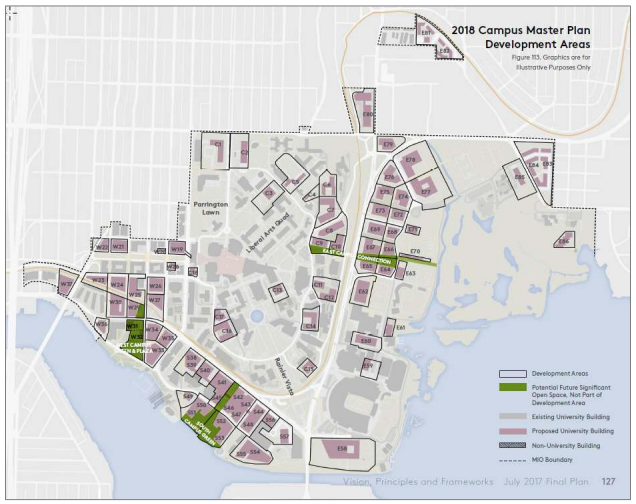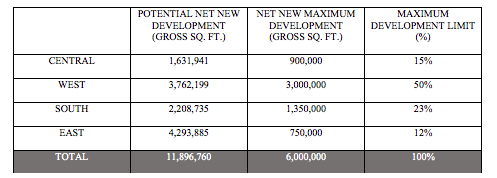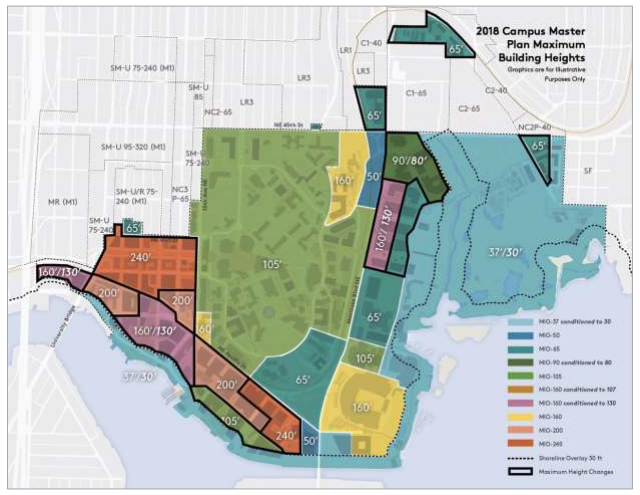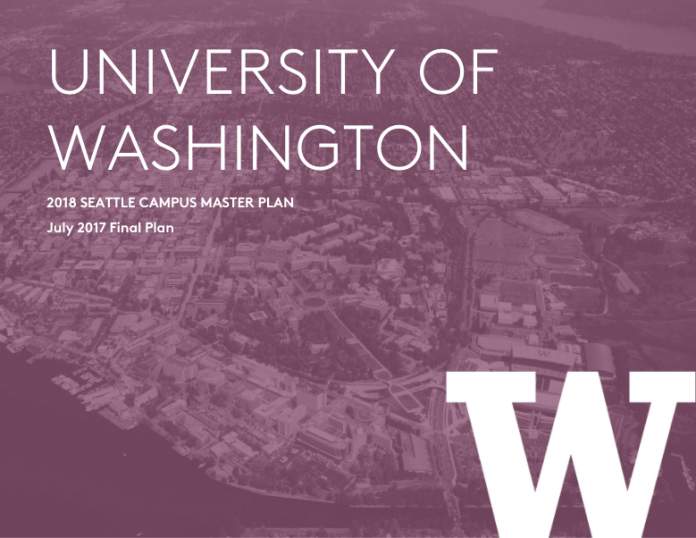On Thursday, the Seattle Department of Construction and Inspections (SDCI) issued a recommendation on the University of Washington Campus Master Plan update. The master plan update seeks to increase overall development capacity on the main Seattle campus by allowing taller buildings and more total building square footage. The master plan update would also revise policies surrounding urban design, parking, and open space. SDCI is recommending approval of the master plan, but has added specific conditions and mitigation measures to the proposed master plan update.
Process and Proposal
On December 8th, the city hearing examiner will consider the proposal and SDCI’s recommendations during a public hearing. The hearing examiner could send a recommendation on the proposal to the city council with the same, revised, or additional conditions or remand the proposal back to SDCI to evaluate and address specific issues prior to holding another public hearing. Ultimately, the city council is likely to take up the master plan update sometime next year.
The process to update the master plan began last year when the University of Washington published its Draft Environmental Impact Statement (DEIS) outlining its overarching objectives for redevelopment of the main campus. The university intends to build an additional six million square feet of housing, educational, commercial, community, and supportive space above the current development cap on the main campus. The university estimates that space needs at the main campus will grow through 2028 as another 8,675 students and 4,649 faculty are added. That equates to 20% growth over the total student and faculty population of 67,155 today. In July, the University of Washington published the Final Environmental Impact Statement (FEIS) and 2018 Seattle Campus Master Plan updating plan elements in response to comments from the DEIS.

The main campus is broken up into four main sectors with 86 potential development sites:
- Central Campus, which has 18 identified potential development sites and is the heart of the main campus.
- West Campus, which has 19 identified potential development sites and is anticipated to have the largest potential for growth during the life of the master plan.
- South Campus, which has 20 identified potential development sites and is composed mostly of the sciences and medicine–including an active teaching hospital.
- East Campus, which has 29 identified potential development site and is mostly composed of a smattering of properties north of the athletics area.

In terms of zoning, the campus master plan envisions a range of building heights as low as 30 feet near the water and as high as 240 feet near the core of the University District. The proposed zoning would substantially increase allowed building heights–and thereby allowed building square footage–in select areas of university’s Major Institution Overlay (MIO), a special zoning for institutional uses like the University of Washington. However, most of the proposed zoning is designed to transition carefully with adjacent properties outside of the university’s MIO.

The FEIS proposes slightly reduced zoning heights than the DEIS had envisioned. All of these changes were made at the edges of the MIO boundary, particularly in the West Campus area. For instance, the small pocket of 65-foot zoning at the north end of West Campus had originally been envisioned as 240-foot zoning. Likewise, the 160-/130-foot zoning proposed at the west end of the West Campus had been uniformly proposed as 200-foot zoning during the DEIS.
SDCI’s Recommended Conditions
SDCI is recommending 61 conditions on the master plan, most of which modify certain master plan attributes proposed in the FEIS. However, a bit more than a dozen proposed conditions would act as mitigation measures under State Environmental Policy Act (SEPA). The city has substantive authority to attach conditions under SEPA in order to lessen the impacts assumed by a proposal. The following summarizes some of the key conditions contained in the recommendation:
Social and Cultural Conditions
- Affordable housing. SDCI is recommending that the 150 affordable housing units be set aside for faculty and staff earning less than 60% of the area median income. The university would need to construct them within the campus, primary impact zone, or secondary impact zone prior to developing any square footage above the current cap. In other words, the university would need deliver the affordable housing units prior to constructing any of the six million in additional square footage that the updated master plan would allow. The FEIS did not stipulate the level of affordability for units nor who they should be designed for; it also did not lay out the timing for construction of affordable housing.
- Historic preservation. SDCI is recommending that language on demolition of potentially historic structures be removed from the master plan. This is in keeping with a Washington State Supreme Court decision this year that the city won allowing local preservations laws, amongst other land use laws, to govern on university-owned property. Specifically, SDCI is recommending that following language be struck: “Demolition of any structure, including any structure that is more than 25 years old or historic, is allowed if authorized by the UW Board of Regents.” For the sake of consistency, SDCI is also recommending that language like “balances preservation of historic campus assets with increased density” and “growth that balances the preservation of historic campus assets with intensive investment” be struck from the master plan. This would ensure the primacy of the city’s landmarks laws are maintained.
Height, Bulk, and Scale Conditions
- Building heights. SDCI’s recommendation generally supports the increased building heights proposed by the master plan. However, the recommendation proposes to retain lower building heights on four sites in the West Campus. In the case of W19 and W20, the building heights are proposed to be capped at 105 feet which would be no change from today. The primary purpose is to keep a softer transition to properties zoned NC3-65 to the north than 240-foot heights would provide. For W31 and W32, SDCI is recommending that the sites be capped at 30 feet instead of 130 feet since they are planned to contain pavilion uses as part of the large central green.
- Upper-level stepbacks. Generally, buildings over 45 feet in height would be required to provide a 20-foot upper-level stepback to reduce building bulk. SDCI wants to clarify the application of upper-level stepbacks so that they apply to facades facing streets and major public open spaces. The master plan language is vaguer suggesting that the such stepbacks could apply to at least two facades.
Transportation Conditions
- Transportation Demand Management (TDM). To achieve lower drive-alone rates to the university campus, SDCI is recommending performance monitoring requirements and lower drive-alone rates over the next decade. The status quo drive-alone rate is 20%. Under SDCI’s recommendation, the university would need to achieve a 15% drive-alone rate by 2024 or one year after the Lynnwood Link extension opens, whichever occurs earlier. There are other interim objectives outlined to that point in time, too. Should the university fail to meet lower drive-alone rates as outlined, the university would need to institute other TDM strategies to foster the desired drive-alone rates. Possible measures include providing a 50% minimum transit pass subsidy for staff, expanding the U-Pass to integrate with carsharing and bikesharing platforms, instituting demand-based paid parking strategies, and eliminating monthly parking permits. Continued failure to attain TDM goals after a period of 24 months could allow SDCI to deny any further building permits until the goals are met.
- Transit improvements. SDCI is recommending that the university pay for a variety of transit improvements. This includes installation of new RapidRide stops on NE 45th St, 15th Ave NE, and NE Pacific St, covering partial cost of intelligent transit signals at key intersections, purchase three bus coaches for King County Metro Transit, and pay significant project costs for RapidRide corridor segments near the campus.
- Bicycle parking. The master plan suggests that new development should consider opportunities to create bicycle parking. SDCI, however, is recommending that bicycle parking be provided at a minimum rate based upon 10% of students and 5% of staff present at peak hours.
- Burke-Gilman Trail upgrades. SDCI is recommending that the university complete its upgrades of the Burke-Gilman Trail running through the campus and install lighting meeting city standards. The university has a high quality trail standard separating bicyclist and pedestrians. Completion of this would be expected by 2022 or as sites adjacent to the trail develop, whichever is earlier.
- Parking access. The master plan places a general preference toward parking access from streets owned by the university. This is consistent with city priorities. However, there may be instances where access may be desirable from a city street. SDCI is recommending a clarification to the master plan that SDCI, in consultation with the Seattle Department of Transportation, has the authority to make a final determination on access based on a priority location analysis.
- Continuous waterfront trail. SDCI is recommending that the waterfront trail on the East Campus be completed earlier than proposed in the master plan and regardless of whether or not the East Campus is developed. Under SDCI’s recommendation, the university would need to complete the trail prior to completing 750,000 gross square feet of development in the East Campus or exhaustion of the additional six million gross square feet allowed under the master plan. The trail would need to be completed prior to either scenario, whichever comes first. The trail would also need to incorporate a hand-carry boat launch near at the water’s edge and facility accessibility for those disabled via ADA parking at key access points.
Urban Design Conditions
- Active street-level uses. SDCI is recommending language in the master plan that would require active street-level uses and building transparency for building adjacent to city right-of-way in the West Campus. Examples include 15th Ave NE, University Way NE, and NE Pacific St. SDCI also is recommending that the requirement be applied to all midblock corridors in the campus, buildings fronting the new campus greens, and the continuous waterfront trail. Ideally, these uses would include commercial or childcare uses, but study spaces, lounges, and hands-on educational spaces. Active street-level use spaces would need to achieve a minimum level of building transparency between two and eight feet above sidewalks along at least 60% of a building frontage.
- Gateways. The master plan highlights that “gateways” to the university campus function as important ways for people walking, biking, and driving to access the campus. SDCI is recommending clearer language about how gateways should function and where they’re located. “Gateways should include visual enhancements that signify entries into the community, such as landscaping, signage, artwork, or architectural features that will be installed at the discretion of the University,” the recommendation reads. SDCI also recognizes points like 15th Ave NE at NE 45th St and the landing at NE 40th St near the University Street Bridge as key gateways.
- View corridors. The master plan identifies 12 distinct view corridors on and across the campus. SDCI is recommending stronger language requiring that sites developed adjacent to or within a view corridor demonstrate how an existing or proposed view corridor will be maintained by new development. Some view corridors are considered to be proposed since they would be established over time. SDCI is also requiring some corrections and updates to the view corridors.
Community Leaders Remain Concerned
Last week, community leaders and staff for the University of Washington raised legitimate concerns over the recommendation and university’s proposal. Leading the campaign for a more holistic proposal is the U District Alliance for Equity and Livability. They released a blistering statement against the recommendation going as far to say that the city should completely renegotiate its agreement with the University of Washington due to the recent Washington State Supreme Court ruling allowing the city to fully extend its land use regulatory authority on campus property.
On transportation access and impacts, the Sierra Club’s Bill Roach highlighted how the University of Washington’s proposal could fail to keep buses moving and continue to leave employees behind. “Even if it meets its own traffic reduction goals, the UW admits that 11 out of 13 key U District intersections will be gridlocked (Level of Service E or F) with almost five times more vehicle delay,” Roach said. “The City recommendation today would let them get away with this traffic nightmare for the U District and for transit riders. The UW needs to get those extra commuters on transit, and that means the UW needs to join other major employers like Children’s Hospital and provide free transit passes to employees.”
Environmentalists and university staff have long pushed the university to fully fund the U-Pass transit card for employees, so far to no avail. University employees cover a significant proportion of the transit pass costs under the current U-Pass program. University staff also lack access to free bike lockers on campus.
Affordable housing advocates have laid criticism over the lack of affordable housing contained in the University of Washington’s master plan, despite the fact that adding more jobs and students would increase the struggle for employees and students to attain local affordable housing. Only 150 affordable housing units would be developed under the proposal.
John Castle from the Low Income Housing Institute harshly criticized the scale of affordable housing proposed. “We know what tiny is because we build tiny houses–this is a tiny commitment for a huge institution with thousands of low-wage employees,” Castle said.
Bereket Kiros, a member of the Coalition of Immigrants, Refugees, and Communities of Color, raised concerns over racial equity and displacement. “Immigrants and communities of color were not consulted in the UW’s plan, which will result in more housing displacement for immigrants,” Kiros said.
Under the city’s Mandatory Housing Affordability (MHA) program, rezones are being paired with mandatory inclusionary requirements to build affordable housing on-site or pay a fee in lieu to the city for affordable housing. Generally, the affordable housing requirements are 5% to 10.6% of total square footage for commercial development. Even under the lowest set aside requirements, the University of Washington would be required to provide hundreds of additional affordable units over the baseline proposal if MHA was applied to the university properties.
In addition to these issues, community members and staff have consistently advocated for more childcare near the campus. The master plan does discuss the issue at length suggesting that the ratio of childcare spaces to campus population would eventually fall within the band for other peer universities, but cost of childcare and the severe shortage remains a serious issue for students, faculty, and staff.
SCDI Recommendation
University of Washington Campus Master Plan
Stephen is a professional urban planner in Puget Sound with a passion for sustainable, livable, and diverse cities. He is especially interested in how policies, regulations, and programs can promote positive outcomes for communities. With stints in great cities like Bellingham and Cork, Stephen currently lives in Seattle. He primarily covers land use and transportation issues and has been with The Urbanist since 2014.


